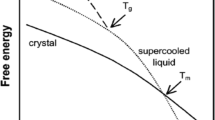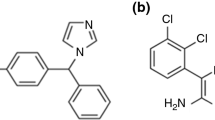Abstract
The temperature modulated differential scanning calorimetry (MDSC®) technique has been used to characterise the low frequency molecular mobility of indomethacin and maltitol just above their respective calorimetric glass transition temperatureT g. Analysis has been made using the concept of complex specific heat. Spectroscopic information are thus obtained through the temperature dependence of the isochronal real and imaginary parts C′ and C″. This gives access to the fragility index m and the stretched exponent β. The comparison with dielectric spectroscopy has been performed to check the coherence of spectroscopic information. Measurements on maltitol enable to demonstrate the useful complementarity of the technique when the low frequencies dielectric relaxations are occulted by the presence of conductors default.
Similar content being viewed by others
References
B. C. Hancock and G. Zografi, J. Pharm. Sci., 86 (1997) 1.
B. C. Hancock, S. L. Shamblin and G. Zografi, Pharm. Res., 12 (1995) 799.
S. L. Shamblin, X. Tang, L. Chang, B. C. Hancock and M. J. Pikal, J. Phys. Chem., 103 (1999) 4113.
O. Bustin and M. Descamps, J. Chem. Phys., 110 (1999) 1.
J. M. Hutchinson, Thermochim. Acta, 324 (1998) 165.
J. E. K. Schawe, Thermochim. Acta, 260 (1995) 1.
J. E. K. Schawe, Thermochim. Acta, 261 (1995) 183.
K. J. Jones, I. Kinshott, M. Reading, A. A. Lacey, C. Nikopoulos and H. M. Pollock, Thermochim. Acta, 304/305 (1997) 187.
J. E. K. Schawe and G. W. H. Höhne, Thermochim. Acta, 287 (1997) 213.
B. Wunderlich, Y. Jin and A. Boller, Thermochim. Acta, 238 (1994) 277.
J. E. K. Schawe and W. Winter, Thermochim. Acta, 298 (1997) 9.
Z. Jiang, C. T. Imrie and J. M. Hutchinson, Termochim. Acta, 315 (1998) 1.
S. Weyer, A. Hensel and C. Schick, Termochim. Acta, 304/305 (1997) 267.
L. Carpentier, O. Bustin and M. Descamps, J. Phys. D: Appl. Phys., 35 (2002) 402.
N. O. Birge and S. R. Nagel, Phys. Rev. Lett., 54 (1985) 2674. N. O. Birge, Phys. Rev. B, 34 (1986) 1631.
M. Yoshioka, B. C. Hancock and G. Zografi, J. Pharm. Sci., 83 (1994) 1700.
E. Fukuoka, M. Makita and S. Yamamura, Chem. Pharm. Bull., 34 (1986) 4314.
M. Siniti, Etude thermodynamique des phénomènes de relaxation des matériaux vitreux. Caractérisation de l’état enthalpique d’un verre de polyol dans le domaine de la transition vitreuse, Ph. D. Thésis, Institut National des Sciences Appliquées de Lyon, 1995.
R. Böhmer, K. L. Ngai, C. A. Angell and D. J. Plazeck, J. Chem. Phys., 99 (1993) 4201.
C. A. Angell, J. of Res. of the National Institute of Standards and Technology, 102 (1997) 171.
V. Andronis and G. Zografi, Pharm. Res., 14 (1997) 410.
V. Andronis and G. Zografi, Pharm. Res., 15 (1998) 835.
R. Böhmer and C. A. Angell, Local and global relaxations in glass forming materials, in Disordered effects on relaxational processes, Springer-Verlag, Eds R. Richert and A. Blumen, 1994.
J. K. Nielsen and J. C. Dyre, Phys. Rev. B, 54 (1996) 15754.
R. Böhmer, E. Sanchez and C. A. Angell, J. Phys. Chem. B, 96 (1992) 9089.
C.T. Moynihan, L. P. Boesch and N. L. Laberge, Phys. and Chem. of Glasses, 14 (1973) 122.
F. Z. Stickel, Untersuchung der dynamik in niedermolekularen flüssigkeiten mit dielektrischer spektroskopie, Verlag Shaker, Aachen 1995.
D. Q. M. Craig, Dielectric analysis of pharmaceutical systems, Taylor & Francis, 1995.
R. He and D. Q. M. Graig, J. Pharm. Pharmacol., 53 (2001) 41.
A. Faivre, L. David and J. Perez, J. Phys. II France, 11 (1997) 1635.
Author information
Authors and Affiliations
Corresponding author
Rights and permissions
About this article
Cite this article
Carpentier, L., Bourgeois, L. & Descamps, M. Contribution of Temperature Modulated DSC® to the Study of the Molecular Mobility in Glass Forming Pharmaceutical Systems. Journal of Thermal Analysis and Calorimetry 68, 727–739 (2002). https://doi.org/10.1023/A:1016080928333
Issue Date:
DOI: https://doi.org/10.1023/A:1016080928333




